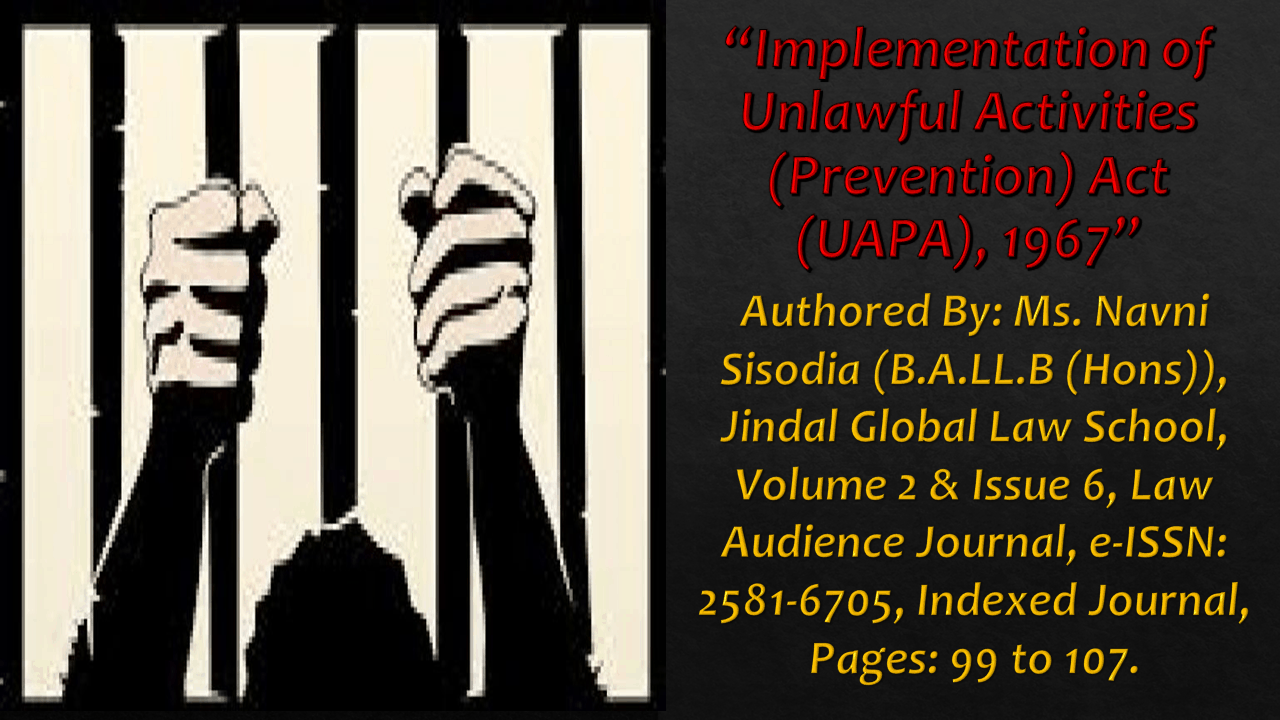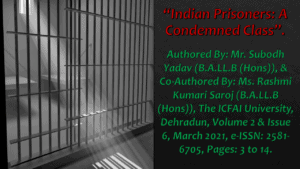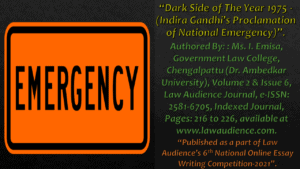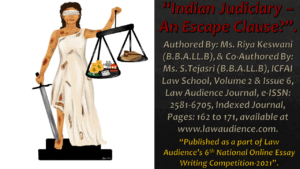Click here to download the full paper (PDF)
Authored By: Ms. Navni Sisodia (B.A.LL.B (Hons)),
Jindal Global Law School,
Click here for Copyright Policy.
ABSTRACT:
“This paper talks about the implementations of the different provisions of the Unlawful Activities (Prevention) Act (UAPA), 1967, by the executives and how such laws give extensive powers to the state with respect to its citizens. There have been a series of laws passed over the years, targeted towards the prevention of terrorist activities such as the Terrorist and Disruptive Activities (Prevention) Act (TADA) which was in force from 1985 till 1995, Prevention of Terrorism Act (POTA) which was passed in 2002 till 2004. The focus of this paper will be on the provisions from the Unlawful Activities (Prevention) Act (UAPA), 1967, the only legislation on terrorism which is still in force, and the way the provisions in this Act were abused by the executive bodies and after such experience, the challenges that the government faces with the implementation of the most recent amendment of the Unlawful Activities (Prevention) Amendment Act, 2019, (UAPA). It also addresses how provisions and the powers it gives to the executive body. Along with that the cases and circumstances which lead to the changes and amendments in the various Acts. It will also be focusing on the process of implementation and the use and abuse of powers which are provided by the Act.”
I. INTRODUCTION:
Many governments have attempted to introduce or introduced enactments which cover offences regarding terrorism and terrorist activities. Every one of these enactments has been followed by its controversies as well. In 1987, the Terrorist and Disruptive Activities (Prevention) Act (TADA) was enacted. It was in force for eight years and got repealed in May 1995, following widespread criticism and allegations from numerous human rights organisations, both national and international, lawyers and even the ministers and government officials. The subsequent legislation introduced was the Prevention of Terrorism Act (POTA) which was passed in 2002 but withdrawn in 2004. Besides these two, the legislation which can be dubbed as the ‘original’ anti-terrorism legislation is the Unlawful Activities (Prevention) Act (UAPA), 1967,[1] which remains in force after several amendments. In its 2004 amendment, most of the provisions of POTA were re-incorporated after the withdrawal of POTA.
II. CHANGES BROUGHT BY THE 2019 AMENDMENT ACT:
The most recent amendment came in 2019, which altered few of the provisions like expanding the definition of ‘terrorist’, under Section 35 and 36 of the Act, to include individuals. Under Section 25(1), the amendment allows an officer of the National Investigation Agency (NIA), after approval from the Director-General of the NIA, seizure of property of proceeds when they are conducting the investigation. Under Section 43, a clause for the grant of powers to an officer of the rank of Inspector of the National Investigation Agency to investigate the offences under Chapter IV and Chapter VI has been included. For the de-notification of an individual, notified as a terrorist, a review committee is to be constituted by the Central Government. This removes all opportunities of institutional mechanism for judicial review.[2]
III. BANNING ASSOCIATION AND CRIMINALIZING MEMBERSHIPS:
The Act has, since its inception, has drawn criticism for its vagueness in different aspects. The word ‘unlawful’ has been ambiguously defined. The term ‘unlawful activity’ has been defined in section 2(o) of the UAPA as any activity which intends to or supports any claim to bring about the cession of a part of the territory of India or incites a group or an individual to bring about such cession; or any activity which disrupts, questions or intends to disrupt the sovereignty or territorial integrity of India; or an activity which causes or intends to cause disaffection against India.[3] Any organisations involved in such activity will be an unlawful organisation.[4] The objectives of the Act include prevention of certain unlawful activities as well as dealing with terrorist activities of organisations or individuals. It can be seen as a legislation which sets out the reasonable restrictions for the limitation of fundamental rights under Article 19(1) of the Indian Constitution which include the right to speech, the right to assembly, right to form associations or unions among others.[5] Section 10, along with Section 20, state the penalty for being a member of an unlawful association[6] and punishment for being a member of a terrorist gang or organisation.[7] Both these sections are widely worded and lay down that mere membership of a terrorist gang or organisation, involved in a terrorist act, can lead to imprisonment for life. In 2011, the Court, in the case of Arup Bhuyan vs. State of Assam, tried to narrow the scope of the definition of ‘membership’ to prevent misuse. The case held that “mere membership of a banned organisation will not make a person a criminal unless he resorts to violence or incites people to violence or creates public disorder by violence or incitement to violence”.[8]
Justice Thipsay in the Bombay High Court judgement of Jyoti Chorge vs. State of Maharashtra, had even termed this as ‘drastic’. The judge also acknowledged the fact that the grant of bail as well is difficult under Section 43D (5), which curtails a court’s discretion which means that the concept of membership under section 10 and 20 of UAPA needs to be carefully contemplated, because of rights provided under Article 19 of the Constitution.[9] The Court held that passive membership does not fall under the ambit of Section 20 and it is included then that makes section 20 violative of Article 19 of the constitution. The Court granted bail to Jyoti Chorge along with the other members of the Kabir Kala Manch, who were accused of being Naxalites, under the provisions of the UAPA.[10]
Therefore, merely being a member of a group deemed or suspected to be unlawful does not make a person guilty under the provisions of UAPA. Although, even after these judgements the State still has an unchecked power to make arrests as the implementation remains arbitrary as we have seen in many cases in the last few years, that many a time, activists also get charged with the incitement of violence along with the membership charge. This leads to the questions of whether the accused were active members of such banned organisations and if they used this membership to incite violence, which becomes the issue of adjudication at the trial. Thus, trapping people in the time-consuming loop of trials under the UAPA.
The Central Government holds a great deal of discretionary power when it comes to banning associations. One way to ban an association would be through executive fiat. The State just needs to designate an organisation as a ‘terrorist organisation’ under the First Schedule of the UAPA. This is possible due to the absorption of the principles under POTA after it was abrogated. While Section 35 gives the State the power to ban terrorist organisations and includes the designation of individuals as terrorists, according to the 2019 amendment,[11] Section 36 lays down the procedure for the de-notification of an organisation.[12] According to the Act, an application is made to the Central Government, in case of rejection, the organisation has the option of applying to a review committee.[13]
This review committee can then review the government’s decision. Under these provisions, the government just has to issue a notification to ban organisations. It does not have to provide the grounds for such notification nor does such a decision get reviewed by an independent authority.
IV. PROCEDURE OF SEARCH AND SEIZURE:
The procedure for search and seizure stated in Section 100 and Section 102 of the Criminal Procedural Code (CrPC) requires a warrant while under Section 43A and 43B, there is no such requirement. These provisions rely on an officer of ‘designated authority’[14] and “…his reason to believe from personal knowledge or information given by any person and taken in writing that any person has committed an offence punishable under this Act…”.[15] The UAPA does not make any distinction between non-cognizable and cognizable offences as under Section 14 an offence under this Act shall be a cognizable offence, totally discarding the requirement of a warrant for search and seizure.[16]
V. PROCEDURE OF ARRESTS MADE UNDER THE UNLAWFUL ACTIVITIES (PREVENTION) ACT (UAPA), 1967:
There is a significant deviation in the procedure of arrests made under the UAPA when compared to the procedure laid out in Article 22 of the Constitution and Section 167 of the CrPC therefore, infringing on the rights of the accused. According to these provisions the person arrested has to be produced before the magistrate within twenty-four hours of the arrest, while under UAPA this rule is mostly ignored.[17] Section 43D (2) talks about the procedure of arrest under UAPA. It specifies the deviations from section 167 of CrPC, doubling the period of police custody to 30 days and permitting the extension of detention of the arrested person from to 90 days even for an offence which would only for a 60-day detention period, in cases while the investigation is on-going.[18]
VI. BAIL AND BAR ON ANTICIPATORY BAIL:
Section 43D (5) of the UAPA talks about the procedure of grant of bail. This provision requires an opportunity to be heard, that needs to be given to the Public Prosecutor concerning the bail application of the accused. The accused shall not be granted bail if, in the court’s opinion, a prima facie case has been established against the accused. This would mean that even without concrete proof, the accused will not be granted bail, and this allows for indefinite imprisonment without conviction. Boiling down to the fact, in simpler terms, that as long as the police make a case, the court cannot grant bail. The UAPA becomes a tool for detaining people rather than convicting them. With almost 67% of the cases resulting in the acquittal of the accused in 2016, according to the National Crime Records Bureau. Even though these cases end up in acquittal, it takes a long time to get acquitted.[19] The indefinite imprisonment without bail and the delay in conducting judicial proceedings are provided under the UAPA, which shows the degree of discretion which can be exercised by the investigating officer or the public prosecutor. Apart from that, Section 43D (4) expressly bars the application of Section 438 of the CrPC, which provides for anticipatory bail, in the cases under the UAPA. The Supreme Court, in its order dated 16 March 2020, dismissed the special leave petition of Anand Teltumbde in the case of Anand Teltumbde vs. The State of Maharashtra. The court rejected the petition per the bar on the application of anticipatory bail, given in the UAPA.[20]
Looking at how the different provisions work under the UAPA, the fact that the Act itself slows down the investigative process is evident. The extended timelines for the filing of the charge sheet, virtually impossible chances of getting bail under Section 43D as the requirement under this section effectively mean that if charges have been framed against a person, it would be impossible for him to get bail. In a recent Supreme Court judgement under Section 45(1) of Prevention of Money Laundering Act, 2002[21], “a near-verbatim bail related provision” as when compared to the UAPA, of this Act was struck down.[22] In the case of Naresh Tekchand Shah vs. Union of India & Another, these provisions were struck down on the ground that such an extreme provision goes against the presumption of innocence and that it is not only arbitrary but also discriminatory.[23]
VII. VIOLATION OF PRINCIPLES OF NATURAL JUSTICE:
The different provisions of the UAPA lead to the violation of the principles of natural justice. The principles of natural justice include some requirements which must be fulfilled in each case. These requirements include adequate notice, the rule of Audi Alteram Partem which means the right to a fair hearing as well as the right to a reasoned decision and bias which includes the different kinds of bias such as personal, pecuniary, subject matter bias. Under the UAPA, there is a shift in the burden of proof. This shift not only violates the principle of natural justice but also violates the principles of the International Covenant on Civil and Political Rights (ICCPR). The ICCPR stipulates that there is a presumption of innocence of the accused, which is a universal human rights principle as well. This shift of the burden of proof on the accused instead of the prosecution violates the fundamental norm.
VIII. DISCRETION OF POLICE:
With the provisions of UAPA, the police and other executive bodies have a lot of discretionary power lying at their disposal. This power has time and again been misused with different agendas in mind, including political. There have been instances of police relying on proceduralism to make sure the accused stays imprisoned for an extended period. Arun Ferriera, an Indian activist who spent five years in jail before being acquitted in 2012, has described in his book how the different police would take turns arresting the accused. After his acquittal in several cases and release from jail, he was arrested again as soon as he stepped out by police officers of a different station.[24]
Similarly, according to Kobad Ghandy, who was accused of being a member of the Maoist party, the police refused to let him leave to appear in a trial in another state. This meant that he had to wait for each trial to get over before moving on to the next one, instead of letting all trials against him run simultaneously.[25] Apart from that, in light of the numerous arrests of activists in the past years, it shows that the provisions of the Act are being used as a tool to in an attempt to curb the dissenting voices. The vague discretionary powers which lie at the disposal of the State can be easily used to incriminate the voices of dissent under charges of the UAPA, infringing on the fundamental rights of the citizens. These arrests of the activists lead to a dilution of distinction between political dissent and criminal act by criminalising this dissent.
The Act gives power to the executive to outlaw critical thinking which goes against the status quo. This was seen in Amitabh Bagchi’s case, who was indicted based on the literature found in his house and the fact that he belonged to a banned organisation.[26] This legislation has, time and again, been accused of giving rise to a culture of political witch-hunts where selected organisations going against the status quo become targets to draconian laws which render their dissent criminal.
Footnotes:
[1] Unlawful Activities (Prevention) Act, No. 37, Act of Parliament, 1967.
[2] Deepali Bhandari & Deeksha Pokhriyal, The Continuing Threat of India’s Unlawful Activities Prevention Act to Free Speech, Jurist Legal News & Research (June 2, 2020). https://www.jurist.org/commentary/2020/06/bhandari-pokhriyal-uapa-free-speech/.
[3] Section 2(o), Unlawful Activities (Prevention) Act, No. 37, Act of Parliament, 1967.
[4] Id. Section 2(p).
[5] INDIA CONST. art. 19.
[6] Section 10, Unlawful Activities (Prevention) Act, No. 37, Act of Parliament, 1967.
[7] Ibid. Section 12.
[8] Arup Bhuyan vs State of Assam, (2011) 3 SCC 377.
[9] Jyoti Babasaheb Chorge v State of Maharashtra, (2012) 6 AIR Bom R 706.
[10] Gautam Bhatia, Speech, Association, Personal Liberty, and the State of Exception: Jyoti Chorge v. State of Maharashtra (Apr. 4, 2018), http://dx.doi.org/10.2139/ssrn.3156473.
[11] Section 35, Unlawful Activities (Prevention) Act, No. 37, Act of Parliament, 1967.
[12] Id. Section 36.
[13] Mayur Suresh, The Slow Erosion of Fundamental Rights: How Romila Thapar v. Union of India Highlights What Is Wrong with the UAPA, (July 23, 2019), http://dx.doi.org/10.2139/ssrn.3423999.
[14] Section 2(e), Unlawful Activities (Prevention) Act, No. 37, Act of Parliament, 1967: “Designated Authority” means such officer of the Central Government not below the rank of Joint Secretary to that Government, or such officer of the State Government not below the rank of Secretary to that Government, as the case may be, as may be specified by the Central Government or the State Government, by notification published in the Official Gazette.
[15] Section 43A, Unlawful Activities (Prevention) Act, No. 37, Act of Parliament, 1967.
[16] Ibid. Section 14.
[17] How Arrests under the Unlawful Activities (Prevention) Act are different from the general criminal law in India, Medium Blog, (Aug. 29, 2018). https://medium.com/nyaaya/how.-arrests-under-the-unlawful-activities-prevention-act-are-different-from-the-general-criminal-13dbffacb748
[18] Section 43D, Unlawful Activities (Prevention) Act, No. 37, Act of Parliament, 1967.
[19] Chaitanya Mallapur & Devyani Chhetri, Why Arrested Activists Shouldn’t Despair: 67% Unlawful Activities Prevention Act Cases Ended in Acquittal/Discharge, IndiaSpend, (Sept. 8 2018), https://www.indiaspend.com/why-arrested-activists-shouldnt-despair-67-unlawful-activities-prevention-act-cases-ended-in-acquittaldischarge-99067/.
[20] Anand Teltumbde vs The State of Maharashtra, Order dated 16 March 2020.
[21] Section 45(1), Prevention of Money Laundering Act, No. 15, Act of Parliament, 2002.
[22] Mayur Suresh, The Slow Erosion of Fundamental Rights: How Romila Thapar v. Union of India Highlights What Is Wrong with the UAPA, (July 23, 2019), http://dx.doi.org/10.2139/ssrn.3423999.
[23] Naresh Tekchand Shah v. Union of India & Another WP(Crl) 67 of 2017.
[24] ARUN FERREIRA, COLOURS OF THE CAGE: A PRISON MEMOIR (New Delhi: Permanent Black 2014).
[25] Kobad Ghandy, Subverting the legal system, 46 Econ. Political Wkly. 5, (2011).
[26] Anushka Singh, Criminalising Dissent: Consequences of UAPA, 47 Econ. Political Wkly. 14, 14-18 (2012).
Bibliography:
I. Cases:
-
- Anand Teltumbde vs. The State of Maharashtra, Order dated 16 March 2020
- Arup Bhuyan vs. State of Assam, (2011) 3 SCC 377.
- Jyoti Babasaheb Chorge vs. State of Maharashtra, (2012) 6 AIR Bom R 706.
- Naresh Tekchand Shah vs. Union of India & Another WP(Crl) 67 of 2017.
II. Legislations:
-
- Unlawful Activities (Prevention) Act, No. 37, Act of Parliament, 1967.
- Constitution of India, 1950.
- Prevention of Money Laundering Act, No. 15, Act of Parliament, 2002.
III. Websites:
-
- IndiaSpend (June 8, 2020), https://www.indiaspend.com/why-arrested-activists-shouldnt-despair-67-unlawful-activities-prevention-act-cases-ended-in-acquittaldischarge-99067/.
- The Jurist (June 7, 2020), https://www.jurist.org/commentary/2020/06/bhandari-pokhriyal-uapa-free-speech/.
- The Medium (June 5, 2020), https://medium.com/nyaaya/how-arrests-under-the-unlawful-activities-prevention-act-are-different-from-the-general-criminal-13dbffacb748.
IV. Articles, Reports & Books:
-
- Anushka Singh, Criminalising Dissent: Consequences of UAPA, 47 Econ. Political Wkly. 14, 14-18 (2012).
- ARUN FERREIRA, COLOURS OF THE CAGE: A PRISON MEMOIR (New Delhi: Permanent Black 2014).
- Gautam Bhatia, Speech, Association, Personal Liberty, and the State of Exception: Jyoti Chorge v. State of Maharashtra (Apr. 4, 2018), http://dx.doi.org/10.2139/ssrn.3156473.
- Kobad Ghandy, Subverting the legal system, 46 Econ. Political Wkly. 5, (2011).
- Mayur Suresh, The Slow Erosion of Fundamental Rights: How Romila Thapar v. Union of India Highlights What Is Wrong with the UAPA, (July 23, 2019), http://dx.doi.org/10.2139/ssrn.3423999.
Cite this article as:
Ms. Navni Sisodia, Implementation of Unlawful Activities (Prevention) Act (UAPA), 1967, Vol.2, Issue 6, Law Audience Journal, Pages 99 to 107 (2021), available at https://www.lawaudience.com/implementation-of-unlawful-activities-prevention-act-uapa-1967/.




